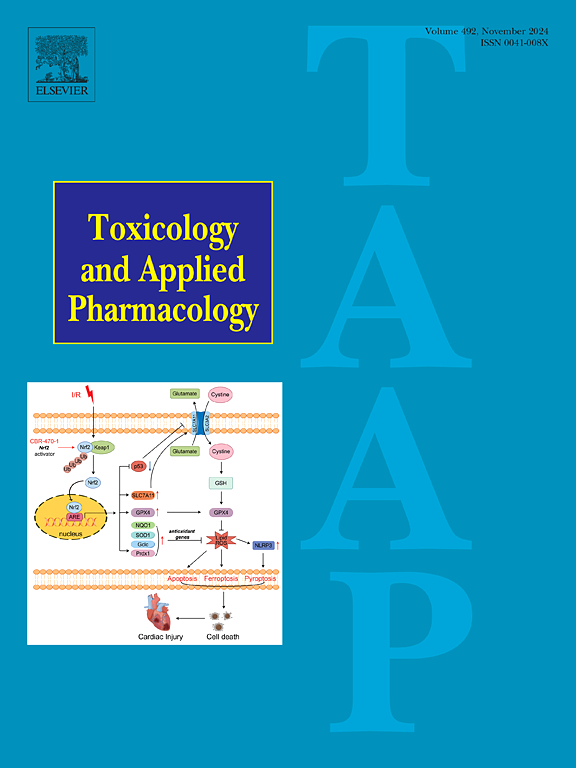Nrf2 deficiency aggravates hepatic cadmium accumulation, inflammatory response and subsequent injury induced by chronic cadmium exposure in mice
IF 3.3
3区 医学
Q2 PHARMACOLOGY & PHARMACY
引用次数: 0
Abstract
Prolonged cadmium (Cd) exposure leads to Cd accumulation and oxidative damage in the liver. Nuclear factor erythroid-derived 2-like 2 (NRF2) plays a vital role in preventing acute hepatic toxicity of Cd. However, the participation of NRF2 in chronic liver injury, especially in the context of chronic Cd exposure, has rarely been investigated. Here, we explored the involvement of NRF2 in Cd-induced liver injury using Nrf2 knockout (Nrf2-KO) mice chronically exposed to Cd in drinking water (100 or 200 ppm) for up to 24 weeks. We found that absence of Nrf2 exacerbated the Cd-induced liver fibrosis, as evaluated by Masson's trichrome staining and increased expression of fibrosis-associated proteins. Mechanistic investigations using the liver tissues from the animals with 100 ppm Cd exposure for 16 weeks, in which no obvious hepatic fibrosis was observed in both genotypes, revealed that there were diminished expressions of antioxidant and detoxification genes and elevated Cd levels in the blood and liver of Nrf2-KO mice compared with those in wild-type (Nrf2-WT) under basal and/or Cd-exposed conditions. Notably, a bulk RNA-seq of the liver tissues showed lowered mRNA levels of genes related to xenobiotic and glutathione metabolic processes, but elevated mRNA expression of leukocyte migration pathway and adaptive immune pathway in Nrf2-KO mice relative to Nrf2-WT controls, either under basal or Cd-exposed conditions. Our findings demonstrated that Nrf2-KO mice are vulnerable to chronic Cd exposure-induced liver fibrosis, which is partially attributed to a compromised NRF2-mediated antioxidant response, lowered metallothionein expression and subsequent Cd accumulation and inflammatory response in the tissues.
求助全文
约1分钟内获得全文
求助全文
来源期刊
CiteScore
6.80
自引率
2.60%
发文量
309
审稿时长
32 days
期刊介绍:
Toxicology and Applied Pharmacology publishes original scientific research of relevance to animals or humans pertaining to the action of chemicals, drugs, or chemically-defined natural products.
Regular articles address mechanistic approaches to physiological, pharmacologic, biochemical, cellular, or molecular understanding of toxicologic/pathologic lesions and to methods used to describe these responses. Safety Science articles address outstanding state-of-the-art preclinical and human translational characterization of drug and chemical safety employing cutting-edge science. Highly significant Regulatory Safety Science articles will also be considered in this category. Papers concerned with alternatives to the use of experimental animals are encouraged.
Short articles report on high impact studies of broad interest to readers of TAAP that would benefit from rapid publication. These articles should contain no more than a combined total of four figures and tables. Authors should include in their cover letter the justification for consideration of their manuscript as a short article.

 求助内容:
求助内容: 应助结果提醒方式:
应助结果提醒方式:


